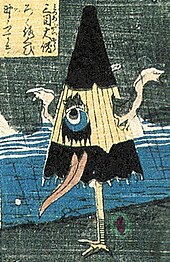Kasa-obake

Kasa-Obake , ( Japanese 傘 お ば け , German "umbrella spirit") also Karakasa-Obake ( か ら 傘 お ば け , German "paper umbrella spirit") and Karakasa-Kozō ( 唐 傘 小僧 , German "umbrella boy “) Called, is a fictional being of the Japanese folk belief that belongs to the group of the lower Yōkai . He is said to have an ambivalent character.
description
The Kasa-Obake is shaped like a large, traditional paper umbrella. It has a single, large eye and a mouth with a very long tongue. Its shaft ends in a human foot or leg with foot, in some cases it wears shoes (for example Geta or Zōri ). It moves by hopping or expanding itself and floating around. In rare cases the Kasa-Obake can also have two human arms and / or two legs.
folklore
In most traditional appear traditions Kasa-obake as naughty but harmless creatures who play their (former) owners tricks: Find it in Ehime Prefecture , the forecast for that one day a verhexter umbrella in the district Higashimurayama unsuspecting strollers that of downpour surprised were tempted to open the umbrella to supposedly protect themselves from the rain. Instead, the Kasa-obake grabbed his victim by the wrist and carried them away for miles.
background
The design model was the bankasa ( 番 傘 ), a large, expandable umbrella or parasol, which was particularly popular in the Edo period . It was a robust everyday umbrella with a short, relatively thick shaft, a mass product and intended for the "little man". Expensive luxury items were covered with silk .
The first mentions and illustrations of the Kasa-obake appeared around 1850 (early Meiji period ) in the work Mukashi Banashi Bakemono Sugoroku ( 百 種 怪 談 妖物 雙 六 ) by Utakawa Yoshikazu . In Toriyama Sekien's work, Hyakki Tsurezure Bukuro , a modified form appears, the Hone-Karakasa (in English: "Bony Paper-Umbrella Spirit").
The being Kasa-Obake belongs to a special group of yōkai, the tsukumogami ( 付 喪 神 , dt. "Artifact spirits"): According to Japanese popular belief, household appliances and musical instruments of all kinds can turn into yōkai after 100 years, because too they have a soul. Kasa-Obake also develop a life of their own when they make their “100. Birthday ”, during this time it was too often ignored and felt useless. In retaliation for the neglect (and out of sheer boredom), they pursue and frighten house residents and walkers. Other Kasa-Obake are just doing harmless jokes. Or they just fly away.
Modern
In the early 1970s, the kasa-obake experienced a kind of modern comeback . In various Yōkai films, such as Yōkai Hyaku Monogatari by Yasuda Kimiyoshi from 1968, Kasa-obake appear where they have outstanding roles.
The figure of Kasa-Obake has also found its way into modern novels , manga and anime series. He is one of those yōkai who enjoy great fame and popularity among children and young people in Japan. Children and young people in particular paint Kasa Obake motifs. A jumping jack toy in the shape of the Kasa Obake is also popular. A well-known parody of the creature can be found in the Game Boy game Super Mario Land 2 as an opponent of Mario.
literature
- Michaela Haustein: Mythologies of the World: Japan, Ainu, Korea . ePubli, Berlin 2011, ISBN 3844214070 .
- Friedrich B. Schwan: Handbook of Japanese woodcuts . Iudicium, Munich 2003, ISBN 3-8912-9749-1 , p. 750.
- Laurence C. Bush: Asian Horror Encyclopedia: Asian Horror Culture in Literature, Manga and Folklore . Writers Club Press, San José 2001, ISBN 0595201814 .
- Kenji Murakami: 妖怪 事 典 . Mainichi Shinbunsha, Tokyo 2000, ISBN 9784620314280 .
- Hirotaka Ichiyanagi: 知 っ て お き た い 世界 の の 幽 霊 ・ 妖怪 ・ 都市 伝 說 . Seitōsha, Tokyo 2008, ISBN 9784791615681 , p. 77.
- Lea Baten: Playthings and pastimes in Japanese prints . Shufunotomo, Tokyo / New York 1995, ISBN 0834803445 .
- Katsumi Tada, Zō Jimusho: 日本 と 世界 の 「幽 霊 ・ 妖怪」 が よ く わ か る 本 . PHP Kenkyūjo, Tokyo 2007, ISBN 9784569668871 .
Web links
- Description of the Kasa-obake on Yokai.com (English)
- Presentation of different yōkai in Super Mario Land 2 . (English)
Individual evidence
- ↑ a b Kenji Murakami: 妖怪 事 典 . Pp. 54 & 119.
- ↑ a b Michaela Haustein: Mythologies of the world . Pp. 25 & 40.
- ↑ Laurence C. Bush: Asian Horror Encyclopedia . P. 95.
- ↑ a b Zilia Papp: Investigating the Influence of Edo- and Meiji Period Monster Art on Contemporary Japanese Visual Media . University Press, Saitama 2008, pp. 200–202 ( PDF download ( memento of the original dated February 5, 2017 in the Internet Archive ) Info: The archive link has been inserted automatically and has not yet been checked. Please check the original and archive link according to the instructions and remove then this note. ).
- ↑ a b Katsumi Tada, Zō Jimusho: 日本 と 世界 の 「幽 霊 ・ 妖怪」 が よ く わ か る 本. Pp. 54-57.
- ↑ Lea Baten: Playthings and pastimes in Japanese prints . P. 59.
